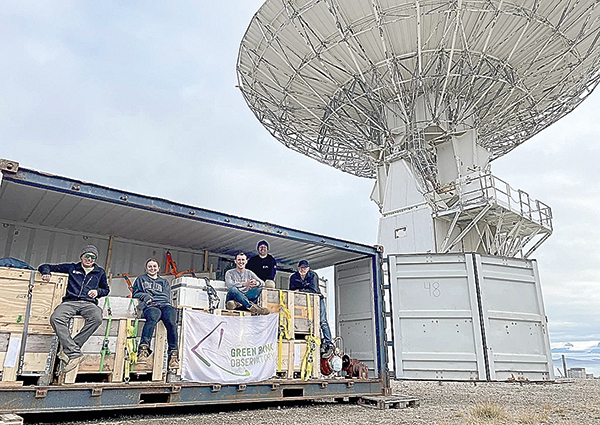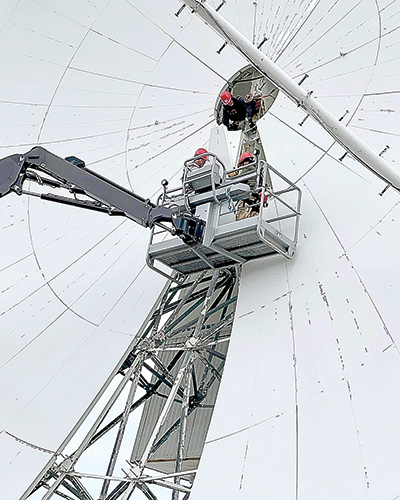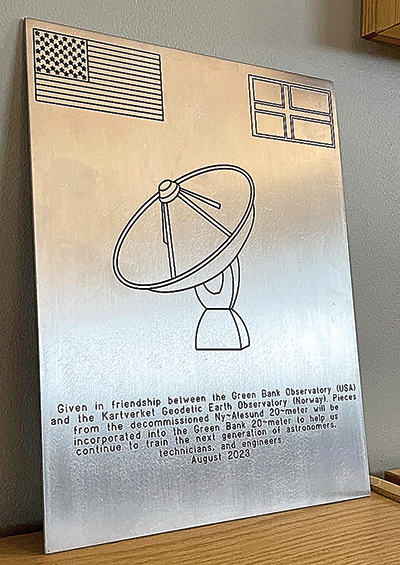
Suzanne Stewart
Staff Writer
After months of planning and preparation, five Green Bank Observatory employees – astronomer Dr. Will Armen- trout, electrician Anthony Nucilli, telescope mechanic Edgar Friel, works area division head Adam Taylor and scientific data analyst Brenne Gregory – traveled 3,783 miles to Svalbard, Norway, where they spent two and a half weeks salvaging parts from the decommissioned 20-meter telescope at Ny-Ålesund research station.
On August 28, the five-member crew held a symposium at the GBO where they discussed the science done at Ny-Ålesund and what they did while they were at the northern-most city in the world.
Armentrout explained that the Ny-Ålesund 20-meter telescope is a twin to the 20-meter at GBO and was built by the same company.
“The impetus for this trip was that they were getting rid of their 20-meter and replacing it with two 13-meters,” he said. “Our objective for going way, way up north was to salvage pieces from their Ny-Ålesund 20-meter telescope, which again, was a twin to ours. The telescope was being decommissioned. It had its last observation Monday, August 14.”
Ny-Ålesund contacted GBO two years ago when the plan to decommission the telescope was set in place and Armentrout said he asked if GBO could salvage parts of the instrument and Ny-Ålesund agreed.
The two 20-meter telescopes were originally built to observe Geodesy, which is a wobble in the Earth. As Armentrout explained, the Earth spins on its axis, which is a regularly occurring movement, but there is also a wobble in the Earth that is less predictable.
The telescopes are used to observe quasars which do not move, so if the telescopes detect movement while observing the quasars, it means the Earth is wobbling.
“Some of them do drift over periods of months or years but, in general, many of them are fairly stable,” Armentrout said of quasars. “We can measure where they are really precisely and use telescopes around the world to measure their locations. When you use two telescopes together, like, let’s say, one in Green Bank and one in Norway, you get really really good resolutions.
“It’s the same as having a gigantic telescope that would be the size of the distance between your two sites,” he continued. “Obviously building a telescope that is the size of the continent of North America is not feasible, but we can build telescopes that are far apart and use them together.”
While the GBO 20-meter is now used for other observations, the Ny-Ålesund 20-meter and, now, the two 13-meter telescopes which replaced it, continue observing Geodesy.
“In 2000, our Green Bank 20-meter stopped this kind of work,” Armentrout said. “The Navy was originally running the 20-meter for the Geodesy experiments here and they stepped away from our 20-meter. So they gave the telescope to the observatory whereas the Ny-Ålesund telescopes continue operating for these types of programs through current day.”
Since the two telescopes are twins, the GBO was excited to be able to salvage parts it might need in the future, to continue use of the 20-meter. The Norwegian Mapping Authority Karverket which owns the 20-meter donated all the pieces to the GBO.

“A wild man with the grinder”
After the three-day trip, the crew landed in Ny-Ålesund in time for a bite of supper and, the next day, they went straight to work. Months prior, they shipped tools, clothing and other supplies to the research station and were ready to deconstruct the telescope.
“Deconstructing the telescope was a whole lot easier than trying to fix something on the telescope,” Friel said. “We could use pretty drastic measures as long as you kept the part you wanted safe, so it was a little easier getting the panels off. We just took a grinder and got them off and worked on the ground.”
“Edgar is a wild man with the grinder,” Taylor said, laughing.
It took the crew a few days to get used to the time change – six hours’ difference – and the cold weather, but once they did, they were like locals, working hard in the 24-hour daylight.
The crew had a 20 by 8-foot shipping container and a meticulous packing plan for the parts as they removed them from the telescope.
“We had to fit all these pieces in there, so the first key to that was getting all the panels because they’re pretty big,” Nucilli said. “We didn’t want them to slide around and get damaged. Adam and Will did a really good job getting that set up. Then we could build everything else around it. Will and Adam pretty much built every single one of those boxes.
“Adam drew everything out before we got started,” he continued. “We had minimal room for error.”
Along with stacking things just right like Jenga blocks, there was also the task of distributing the weight as evenly as possible. With large, heavy equipment going into the container, the crew had to make sure it would ship safely.
The shipping container has a weight limit of 22,000 kilograms.
“We had guessed we were putting 7,000 kilograms in it and when they weighed it, we had put 6,800 kilograms in it, so we were close,” Armentrout said.
Since the container was internationally shipped, every item had to be accounted for with a serial number and estimated worth for the tariff papers.
“Brenne took care of all the customs paperwork,” Nucilli said. “Every single piece, all the boxes were completely packed with stuff, so every single piece from a screw to a gigantic motor… had to be accounted for.”
“There were a lot more telescope parts than I thought I would ever know,” Gregory said. “A lot of the stuff is twenty years old and not sold anymore, so you’re just sort of guessing on prices and then accounting for inflation.”
While they were deconstructing the telescope, Nucilli said he noticed Ny-Ålesund also had a stockpile of spare parts, which was very unlike GBO. At first, he was disappointed, until he realized why a stockpile is a necessity in Ny-Ålesund.
“We realized, when we shipped two boxes full of tools, some boots, some of our winter clothing there – it took about a month-and-a-half, two months,” he said. “Then you understand. You have to have the parts because if you don’t have it and it breaks, you can’t get one. They were very, very prepared for something to break which I thought was impressive. They planned far into the future.”

Twin telescopes,twin towns
Green Bank and Ny-Ålesund have many things in common that only begin with the twin 20-meter telescopes. The northern-most city is also a Radio Quiet Zone and does not allow WiFi or Bluetooth in a 20 kilometer radius.
Gregory said there are signs similar to those in Green Bank that state WiFi and Bluetooth must be turned off on all devices.
“For us, it was very normal because it’s a Radio Quiet Zone,” she said. “I had all my adaptors, and I was ready to go, but for a lot of people who also come to do research, I think they’re not exactly prepared for that because they live in cities where they don’t have to worry about that.”
The radar of cruise ships has caused problems and blown out amplifiers at the research station on multiple occasions.
In addition to radio telescopes, other scientific research is being done on the island, including marine biology.
“They do a lot of climate research there, as well, so they’re looking at permafrost,” Gregory said. “All the buildings are actually built on stilts because you’re building on permafrost rather than bedrock. When they were building the new telescopes, they had to dig down really deep in order to reach that bedrock.”
There is also a lot of wildlife at Ny-Ålesund, including arctic foxes, polar bears and reindeer.
“Not quite as majestic as you’d think they look,” Gregory said of the reindeer. “They’re kind of short and round. The reason they are short is a kind of cool evolutionary trait. Ny-Ålesund doesn’t have any trees or large vegetation because of the winds and the snow, and the environment, so there’s all these little micro greens. The reindeer have evolved to be short so they can reach the ground. During the summer they eat a lot of greens and they get really round.”
Time for exploring
When they weren’t working, the crew did have time to explore the island and its beauty. There was time for several excursions, for which they had protection. If they left a certain perimeter, the crew was required to be accompanied by “body guards” with guns in case they came across polar bears.
Armentrout and Nucilli were also armed after they took a polar bear safety course. The weapons are a last resort, but necessary if the polar bears cannot be scared away by a flare gun or the group acting as one large creature.
Luckily, the weapons did not have to be used.
For the first big excursion, the group went on a hike to a glacier which looked closer than it actually was.
“We dilly-dallied,” Taylor said. “I think every rock got a picture, every flower got a picture. On the way back, we took a short cut and that short cut took us across this pretty large, kind of alluvial floating plane. When we got there, there was no crossing and there was no getting around it without going all the way back around and it looked pretty shallow.”
Taylor said he was thinking they would have to cross through the freezing cold water when he looked up and saw Friel already on his way.
“I look up, and there’s Edgar, pants up around his knees, no shoes, just going across,” he said, laughing. “That was some cold water. When you were walking across the rocks, it felt like knives were just slicing the bottom of your feet.”
The group even got to take a boat out on a lake. They weren’t allowed to drive a vehicle during their time there, but Taylor said, as long as the person steering the boat was born before 1980, they could go out on the water.
“You didn’t have to ever drive a boat before,” he said. “Edgar hadn’t. So Captain Edgar took us out, and we got to go see the sites.”
Back to America
After 14 days away, the group landed in Washington, D.C. and returned to Green Bank and work.
“First of all, I think we definitely accomplished our goal,” Armentrout said. “We brought back about a million dollars in spare parts for the 20-meter. This was an amazing and rare opportunity to work with these partners. It’s not every day you have a telescope full of spare parts that you go get. If we could find a GBT somewhere else, we could be happy to go there.
“It was also a great international collaboration for these people who were willing to give us all the spare parts so they have a second life instead of selling them for scrap,” he added.
The shipping container of parts is currently sitting in northern Norway waiting to be certified for a trans-Atlantic journey.
“At the earliest, we hope to see it here in late October for unboxing,” Armentrout said. “As for the 20-meter in the future, it will hopefully continue on its educational program. We have some discussions on potential new avenues for it, including not just education but satellite downlinks or triggering it for transient discoveries with these new telescopes coming online that are discovering new things nightly that are happening in the sky.”


